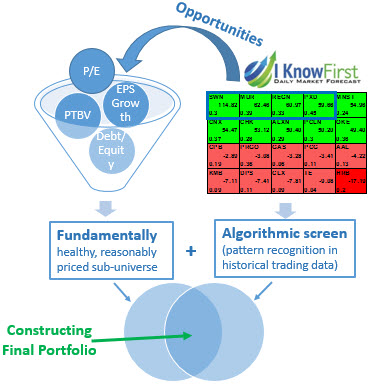Top 3 Stock Valuation Methods Plus the Algorithmic Valuation Tool
 Tali Soroker is a Financial Analyst at I Know First.
Tali Soroker is a Financial Analyst at I Know First.
Stock Valuation Methods
May 24th, 2016
Summary
- What is stock valuation?
- Absolute Valuation versus Relative Valuation
- Examples of Valuation Methods
- Stock Valuation with the Algorithm
- New Fundamental Package!
Stock Valuation
The share prices for assets vary not only on a day-to-day basis but on a minute-to-minute and even second-to-second basis. There are many reasons for these fluctuations in prices, but it essentially comes down to the inability to discover the true value of any asset. Prices for assets constantly overshoot or undershoot an imaginary point of equilibrium called the “fair price”.
As share prices fluctuate daily, investors and analysts do what is called stock valuation in order to determine the essential value of particular stock or asset. There are innumerable valuation techniques that can be used for this determination as each stock is unique and each industry has unique properties that need to be taken into account.
Valuation methods can be divided into two basic categories: Absolute Valuation and Relative Valuation.
Absolute Valuation
Absolute valuation strictly consists of the fundamentals of the asset that is being analyzed, without taking into account comparable assets within the same industry. Some of the most common fundamentals that analysts look at include the company’s cash flow, profit retention, and gross margins. By looking at a company’s fundamentals, investors can examine the overall “health” of the company and determine the value of the stock.
Investors, then, are looking at key factors in the company such as dividends, gross margins, and cash flow. Some of the most common methods of determining a stock’s absolute value include using discounted cash flow (DCF) analysis and the dividend discount model (DDM).
The discounted cash flow method involves using future free cash flow projections and applies discounts to them in order to arrive at an estimation of the company’s current value. This estimation is then used to evaluate whether there is potential for an investment to see growth. When the current value that is calculated is higher than the actual current cost of the asset, there is an assumption that the market will move upward to correct the gap in stock price and stock value. While DCF models are a powerful tool for stock valuation, there is a possibility for error based on chosen inputs and even small changes in inputs can cause major discretions in the estimated value that is found.
Investors using the dividend discount model use a similar discounting method, but look at predicted dividends rather than future cash flow.
Relative Valuation
Relative valuation methods, on the other hand, involves comparing the relative strength of a company to those within its industry. The process involves company fundamentals such as price-to-earnings (P/E) multiples, price-to-sales (P/S), and price-to-cash flow (P/CF). Once calculated, these ratios can be used to compare different companies. Of these, the P/E ratio is the most commonly used because a company’s earnings are a major driver of the stock price.
A company’s price-to-earnings ratio is calculated by dividing the market value per share by the company’s earnings per share (EPS). The EPS is most commonly found from the last four quarters, which is used to find the trailing P/E ratio, but it can also be taken from estimates of future earnings; this form of P/E ratio is called projected or forward P/E. Whether using a trailing P/E or a forward P/E ratio, the number represents the dollar amount that an investor should invest in order to expect one dollar of the company’s earnings.
There are three possibilities for a company’s P/E ratio, it can be high, low, or negative. If the P/E ratio is high, it indicates that the stock is trading for a high price and/or the company’s earnings are relatively low. It shows that investors are paying a premium for lower earnings, which could indicate that the company is set to see higher growth in the future, or the earnings are stable and risk is low. Another possibility is that the stock is overvalued. Conversely, when the ratio is low, the share value is low and earnings are high relative to each other. This could mean that the stock is undervalued and that the share price will increase. But this could also mean that the company is now in trouble, the stock price has fallen, which is reflected in the low current price per past earnings patio, but the future earnings are not assured. There are various methods to help distinguish between these opposite possibilities. In the case that a company is not producing positive earnings, the P/E ratio is not useful and is marked as N/A.
The average market price-to-earnings ratio lies somewhere between 15 and 25 times earnings, but P/E ratios tend to vary between industries, so they are most useful in comparing the ratios between different companies in the same sector.
Valuation from the Predictive Algorithm
I Know First’s machine-learning algorithm uses relative valuation methods to analyze assets across more than 10,000 different markets. The algorithm is consuming and utilizing data, not just from individual companies, but from the full market spectrum. The assumption is that the market itself is the best entity to examine for price discovery, and not a spreadsheet that doesn’t include all of the relevant information. Even all three of these top valuation methods are combined, the actual stock value may not be accurately reflected. There are many inputs that are missing from the analysis, and in some cases non-objective factors determine a stock’s price more than company fundamentals. Apple, for example, has a reputation with consumers and if that reputation is damaged it will dramatically affect the stock price despite company cash flow, dividends, etc. With the extensive range of data that is inputted into the algorithm, the system is able to produce forecasts not only for company stocks, but for currency pairs, commodities, and even the S&P 500 which is commonly used as a benchmark for the state of the economy as a whole.
At the end say that all these combined to not accurately reflect the actual value. There is a lot of inputs that are missing, because they are subject to non-objective interpretation, such as the value of intangibles, IP (intellectual property). Sometimes a company is a sum of parts (business units), and a part could be more valuable if it was on it’s own. All these can affect the final score.
I Know First’s New ‘Fundamentals’ Algorithmic Filter
Our R&D team recently added a new stock package using a fundamentals filter. This new forecasting package includes algorithmic forecasts for stocks based on several fundamental criteria. Investors can choose to filter stocks based on high and low values for the following four valuation indicators:
- P/E (price-to-earnings ratio)
- PEG (price/earnings-to-growth ratio)
- price-to-book ratio
- price-to-sales ratio
Additionally, our institutional clients can customize their forecasts to be screened for the valuation indicators that are most relevant to their personal trading strategy.



















